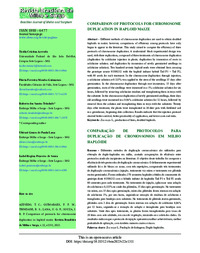Comparison of protocols for chromosome duplication in haploid maize.
Comparison of protocols for chromosome duplication in haploid maize.
Author(s): AZEVEDO, T. C.; GUIMARAES, F. F. M.; TRINDADE, R. dos S.; LANA, U. G. de P.; SOUZA, I. R. P. de
Summary: Different methods of chromosome duplication are used to obtain doubled haploids in maize; however, comparisons of efficiency among protocols have only begun to appear in the literature. Therefore, this study aimed to compare the efficiency of three protocols of chromosome duplication. A randomized block experimental design was used, with three replications composed of three treatments of chromosome duplication (duplication by colchicine injection in plants, duplication by immersion of roots in colchicine solution, and duplication by immersion of newly germinated seedlings in colchicine solution). Two hundred seventy haploid seeds were obtained from crossing the genotype source 91500212 with the haploid inducer hybrid Tail P1 × Tail P2, with 90 seeds for each treatment. In the chromosome duplication through injection, a colchicine solution at 0.125% was applied to the stem of the seedlings 15 days after germination. In the chromosome duplication through root immersion, 15 days after germination, the roots of the seedlings were immersed in a 1% colchicine solution for six hours, followed by removing colchicine residues and transplanting them in trays with the substrate. Finally, in the chromosome duplication of newly germinated seedlings, three days old seedlings were immersed in a 0.06% colchicine solution for 12 hours, then removed from the solution and transplanted in trays with the substrate. Twenty days after treatment, the plants were transplanted in 20-liter pots with fertilized soil in a greenhouse, beginning data collection. Results indicate that the injection protocol showed better survival, better practicality of application, and lower costs and risks.
Publication year: 2023
Types of publication: Journal article
Unit: Embrapa Maize & Sorghum
Keywords: Doubled haploids, Duplo haploide, Linhagem, Milho, Production of lines, Zea Mays
Observation
Some of Embrapa's publications are published as ePub files. To read them, use or download one of the following free software options to your computer or mobile device. Android: Google Play Books; IOS: iBooks; Windows and Linux: Calibre.
Access other publications
Access the Agricultural Research Database (BDPA) to consult Embrapa's full library collection and records.
Visit Embrapa Bookstore to purchase books and other publications sold by Embrapa.

